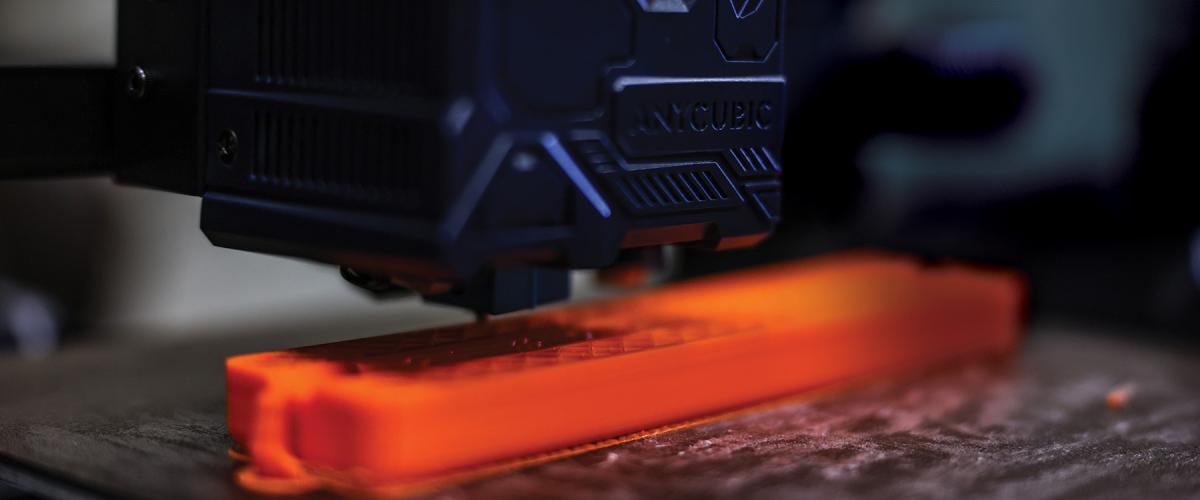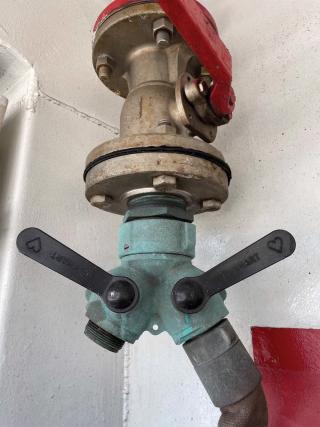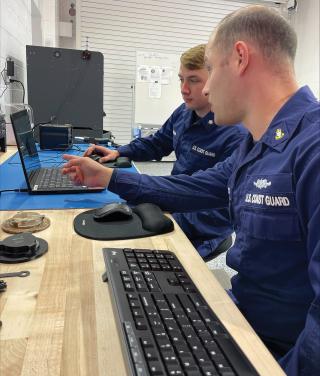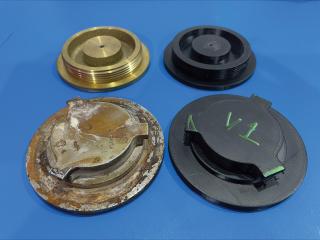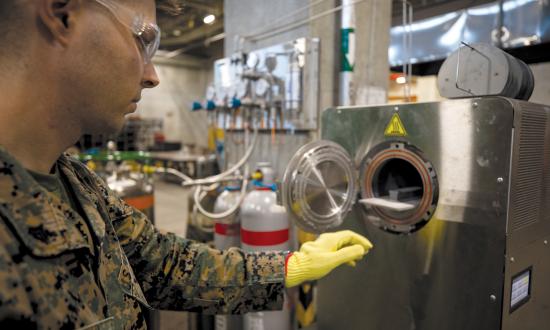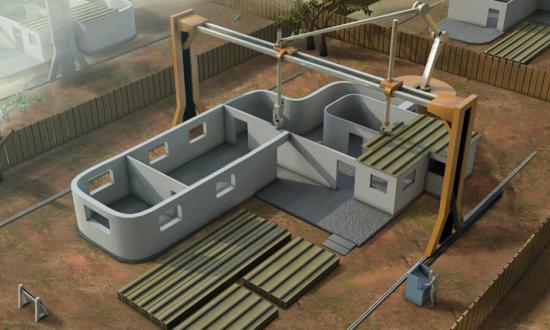Additive manufacturing—also known as 3-D printing—is having an identity crisis, influenced by myths, misperceptions, and differing perspectives. Proponents of the technology tout it as the future, envisioning a ship that carries no spare parts, only 3-D printers.1 On this ship, the printer will spring to life as soon as a part is needed, and the item will be ready and waiting for the sailor in minutes. Those who are more reserved about additive manufacturing (AM) envision ships irresponsibly printing flimsy, unreliable parts that damage systems or, worse, hurt or kill sailors. Some people also think AM is only useful as a hobby, wherein people make their own knick-knacks and toys. Regarding military application, which view is accurate?
AM is a rapidly emerging technology influencing today’s manufacturing industry.2 AM can be difficult to understand because of its breadth and hard to classify because its capabilities are as varied as military assets. Just as the Coast Guard would not send a small boat to do a helicopter’s mission or a national security cutter up the Mississippi to work on buoys, it must ensure AM is not used inappropriately. Thankfully, the Coast Guard has created guidelines that govern how the service can best implement AM.
AM Capabilities and Limitations
Before determining how the military can best employ this technology, it is important to understand its capabilities and limitations. AM currently includes seven different processes, each of which is capable of printing in multiple materials: material extrusion, binder jetting, directed-energy deposition, material jetting, powderbed fusion, sheet lamination, and vat photo-
polymerization.3 The most common type is material extrusion, which has been the Coast Guard’s focus.4
Material extrusion uses a heated printhead through which a solid material is forced and becomes a gel-like fluid—akin to the way a hot-glue gun works. Once in fluid form, the material is deposited accurately via the printhead. The hot gel-like material heats the previous layer and adheres to it. The new addition then cools, solidifies, and forms the next layer of the part. The completed object is the totality of potentially thousands of layers of material. The material extrusion process ranges from polymers printing 0.2 mm in each layer to metal printers fabricating rockets or extruding concrete to build houses a few inches at a time.5 The Coast Guard has focused on polymer material extrusion printing because of its low material cost, relative maturity, and variety of available equipment and suppliers.6
Evaluation Process
AM can be used for rapid prototyping, part production, customization, form blocks, tool and jig creation, and more.7 While the Coast Guard still is relatively new to AM, it is confident in its aptitude thanks to motivated service members who pursue this technology on their own. This growing organic experience helps the service frame the big question: “What should be printed?” The Coast Guard has answered this question by creating a comprehensive, technically rigorous, nimble process that evaluates and validates each proposed part for AM using three phases: triage, development, and deployment.
Triage
Triage is the phase in which the decision is made whether to commit time and materials toward printing a requested part. Specifically, it is a combination of a thorough submittal, an assessment of risk, and an analysis of part criticality. Just as operational commanders must understand the mission and the assets, AM decision-makers must understand the part requirements and printer capabilities.
The triage phase is initiated by a request, which can come from any member or unit. Coast Guard members should submit requests for AM through their normal engineering support paths, ensuring all entities are aware of the need. The standardized request form solicits the needed part’s applicable information, which falls into three categories: what type of part, why is there a need to fabricate the part, and what the part is subject to. Questions on the form include:
• Is it a new design or are we reverse engineering a broken item?
• Will it be on an afloat asset?
• Is it subject to excessive loads, high temperatures, chemicals, ultraviolet light, and/or electrical current?
• How and at what frequency does it fail?
• What would be the operational impact of failure?
Once reviewed locally, the form is submitted to the AM integrated product team (AM-IPT)—a multiunit team of subject-matter experts that shepherds the request through the workflow. After the AM-IPT verifies the request is feasible, the appraisals begin.
Risk assessment is built into all operations and processes to mitigate as much risk as possible and determine if an operation is worth the forecasted dangers. The next part of the triage phase is a discussion among the end user, the asset support representative, the technical warrant holder for the system, and a member of the AM-IPT. Concerns range from meeting industry standards to statistically unlikely “what if” scenarios and “idiot-proofing” ideas. While considering far-fetched situations does take time, the comprehensive analysis put into each decision is a testament to the gravity associated with manufacturing a part for use by service members.
In addition to assessing the risks, mitigation strategies are proposed and enacted, highlighting AM’s agility. Parts can easily be modified to address a concern; for example, strengthening the new part if a previous one broke or adding an embedded label or tag to ease identification. The outcome of the risk analysis would be either a stop, at which no more time or effort is committed to the part, or a go, with the applicable mitigation strategies. If it is a go, then it is on to the next evaluation: criticality.
Where the risk conversation views the immediate effect of an AM part, the criticality assessment answers the question of what could go wrong if the greater system is compromised. For example, for a light switch, the risk could be that someone gets an electric shock, whereas criticality could be that the room stays dark and a service member cannot see the fire extinguisher. Reviewing some of the prompting questions on the assessment gives a good sense for these discussions:
• Does part failure endanger life or mission or potentially create cascading failures?
• Is the part material available for AM?
• Will the part solely be used as a process component to reproduce an existing part?
• Is the part material compatible with the operating environment?
• Is this a nonpermanently installed tool or jig?
Assuming the part has been viewed from every critical vantage point, the final step is to assign it a classification, or, as it is rather unceremoniously termed, “put it in a box.” The boxes are the same color-coded boxes as those implemented by Naval Sea Systems Command: green, blue II–IV, and red. Green indicates the consequence of failure is negligible and there are no material or performance/test criteria. Generally, any green-box part can be fabricated on any approved printer by any service member—for example, a protective cover or a shipping crate fixture. Blue II, III, and IV parts have low, moderate, or high failure consequences or require some material-, industry-, or application-specific testing. Red-box parts are a no-go because the risk is too high or the AM technology is not available.
The Coast Guard has been taking a risk-averse approach by focusing on green, blue II, and blue III parts as AM capabilities and comfort levels grow. However, because situations can change and with them the acceptable level of risk, there is an option for emergency approval of parts.
Emergency approvals are still a work in progress, and the Coast Guard has not fully determined the procedure. The first emergency-type case became a modified version of the standard approval process. Instead of the risks and criticality being weighed against an original part, they were compared with a broken or missing part. Key factors discussed were potential for bodily harm and further degradation of the system. As the Coast Guard moves forward, it will need to create more formal waivers to use AM parts without an approved technical data package.
The final decision to implement most likely will rest with the local command but be influenced heavily by the technical authority’s recommendation. Ideally, these conversations and decisions will happen more quickly as the Coast Guard increases its understanding and use of AM.
Development
After the risk and criticality gantlet, it is time for the technical work. The overarching goal of this next phase of the process—development—is to create a physical part and a robust technical data package. Development is an iterative process that combines engineering, AM expertise, trial and error, and design work. The best way to describe this process is to liken it to a service member getting qualified for a watch station. Some of the “sign-offs” that a part must receive are:
• Does it fit correctly?
• Can it be repeatedly produced with proper dimensions?
• Will it be strong enough?
• What quality assurance checks are required after printing?
The approved technical data package positively answers the question, “Does the technical authority have confidence that this part will perform its functions reliably without undue risk to persons or equipment?” For green-box parts, this step could take as little as a single day. A highly complex blue IV box with industry-specific standards could take months to model and send out for verification and testing.
Deployment
The final step is deployment, in which the part is coded in the logistics system, entered into the “eWarehouse” through the Surface Technical Information Portal, and made accessible to all Coast Guard members. Service members can already get all required drawings and technical references through this database; adding part files to this system adds another avenue to find solutions. If it was a reverse-engineered item, the allowance parts lists are updated to show an AM option is available. The approved part is now ready for download by anyone with the proper printer, materials, and capability to produce and verify it. Much like anyone with a qualification letter can go to another unit and fill that position, the part is ready to support the fleet wherever applicable.
Next Steps
The Coast Guard is now able to programmatically implement AM technology. A next step could be to grow inward and partner outward. By using the governance system, the Coast Guard can start build an internal AM network. Employing it in the standard depot and organizational mission support structure pushes capabilities as close to the point of need as possible and provides long-distance support. If operational units are outfitted with high-end hobbyist or prototyping-level printers, they would be able to print a selection of trusted polymer materials such as ABS, ASA, PETG, nylon, and more. A printer of this level has an average build volume of one cubic foot and needs only a few square feet of deck space.8
Support units could be outfitted with larger production-scale printers, twins of the operational printers, and software licenses that include 3-D computer modeling programs. This equipment would allow support units to complete the more technically rigorous work required for new-part approval, supply more complex parts to operational units, and provide proven printer settings to operational units.
A solid framework creates the ability for assets at sea to reach back to support units for assistance during emergencies. Shoreside support would have the capability to model parts and then test and finalize the printer settings on their twins to reduce downtime and increase confidence in temporary and emergency repairs. Internal standardization could have strong benefits across communities—naval, aviation, electronics, etc.—and improve knowledge-sharing and resource-surging opportunities. The Coast Guard has been trending this way through collaborative working groups but it still needs a high-level office to act as the controlling entity.
Looking outward, the Sea Services are poised to create a strong AM relationship. A partnership among the services could quickly become a practical application of the logistics goal envisioned in Advantage at Sea, the triservice maritime strategy. A logical first step would be to create a standard process for cross-service part approval. This would immediately grow every service’s eWarehouse. A large, shared database could reduce the timeline from part requests to implementation and eliminate double work. Starting with parts needed for one of the many shared assets—such as the MH-60 helicopter or shipboard valve handles and deck drains—has the potential to jumpstart a multiservice collaboration because the return on investment would benefit everyone.
Working within these rules of governance, members could use AM to solve logistics, maintenance, and underway habitability issues. Using an operational analogy, triage is the commander’s decision about if and what type of asset to deploy, development is the unit or member’s readiness and qualification, and deployment is the tactical completion of the mission. Through this familiar mission-style approach, sailors should feel as comfortable using an approved AM part as having a new shipmate come in with qualifications. The part’s function has been assessed for risk and criticality, it has been properly developed, and it has a “qual letter.” Just like the phrase that has been said to almost everyone who passes a board, the Coast Guard is able to tell additive manufacturing: Next watch!
1. LT Scott Cheney-Peters and LTJG Matthew Hipple, USN, “Print Me a Cruiser!” U.S. Naval Institute Proceedings 130, no. 4 (April 2013); and Capt Matthew Friedell, USMC, “3D Printing Is a Game Changer,” U.S. Naval Institute Proceedings 142, no. 10 (October 2016).
2. Ian Gibson, David Rosen, and Brent Stucker, Additive Manufacturing Technologies; Rapid Prototyping to Direct Digital Manufacturing (New York: Springer 2010), 17–40.
3. Gibson, Rosen, and Stucker, Additive Manufacturing Technologies.
4. Jason Story, Shalane Regan, and Timothy Hughes, Focus Areas for Coast Guard Additive Manufacturing (New London, CT: U.S. Coast Guard Research and Development Center, February 2020), 1–12.
5. Brent Donaldson, “The Hidden Complexities of Wire Arc Additive Manufacturing,” Additive Manufacturing, 20 January 2020; Carolyn Schwaar, “3D-Printed Rockets Set to Blast Off,” Forbes, 30 June 2022; and Brittany Chang, “The Use of 3D Printing in Homebuilding Is Set to Drastically Expand in 2023,” Business Insider, 30 December 2022.
6. Story, Regan, and Hughes, Focus Areas for Coast Guard Additive Manufacturing, 1–12.
7. Gibson, Rosen, and Stucker, Additive Manufacturing Technologies, 283–314.
8 “The Best Professional 3D Printers (FDM & Resin),” All3DP Pro, 12 March 2023, all3dp.com/1/best-professional-3d-printer-small-business/.



